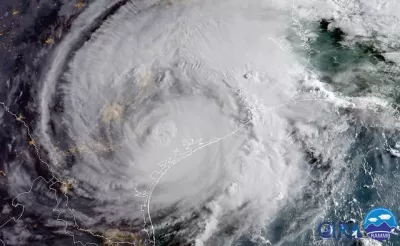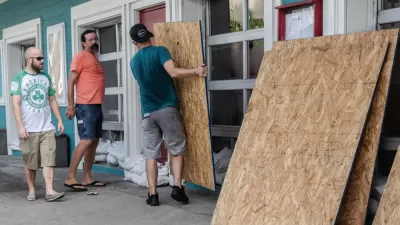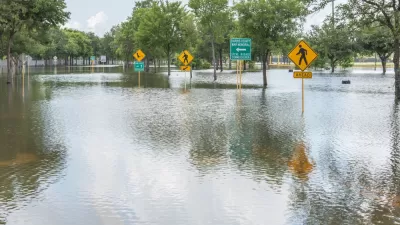A new study from MIT makes a clear connection between the intensity of rainfall caused by Hurricane Harvey last August in Texas and climate change, concluding that the likelihood of stronger downpours is greatly increasing.

"The extreme rains that inundated the Houston area during Hurricane Harvey were made more likely by climate change, a new study suggests, adding that such extreme flooding events will only become more frequent as the globe continues to warm," reports Chris Mooney, who writes about energy and the environment at The Washington Post, on Nov. 13.
The study, "Assessing the present and future probability of Hurricane Harvey’s rainfall," by MIT hurricane expert Kerry Emanuel, was published in the Proceedings of the National Academy of Sciences on Monday.
In the wake of Harvey, many researchers pointed out that a warmer atmosphere holds more water vapor and that, as a result, a warmer planet should see more extreme rains. But Emanuel’s study goes beyond this general statement to support the idea that the specific risk of such an extreme rain event is already rising because of how humans have changed the planet.
The study was based on climate modeling in the Houston area, measuring how much precipitation the simulations caused.
Emanuel conceded that precisely why the simulations changed the odds with greater global warming wasn’t clear — whether it had something to do with more water vapor or other storm characteristics. “This is left to future work,” he wrote.
The study is important to the rebuilding efforts in Houston, as Emanuel indicates as one of the reasons for his study, an confirmed by another expert.
“I guess what I was hoping to achieve was a little bit of a public service," states Emanuel. "There are folks down in Texas who are having to rebuild infrastructure, and I think they need to have some idea of what kind of event they’re building for.”
“The 20-fold future increase in the probability of Harvey-level rainfall points toward a markedly increasing vulnerability of Gulf Coast communities — one that they are not well prepared to adjust to,” added Greg Holland, a hurricane scientist at the National Center for Atmospheric Research.
While the study was focused on precipitation caused by Harvey and the probability of future hurricanes in Texas producing similar amounts of rain, Emanuel went further in a talk at MIT in September, just as Hurricane Maria made landfall in Puerto Rico, reports David L. Chandler for the MIT News Office on Sept. 21.
“Climate change, if unimpeded, will greatly increase the probability of extreme events,” such as the three record-breaking hurricanes of recent weeks, said Emanuel.
The most memorable part of Chandler's piece is Emanuel's jab at Environmental Protection Agency Administrator Scott Pruitt, who had dismissed any climate connection with the amount of rainfall from Hurricane Harvey.
Referring to....Pruitt’s recent comments that it was inappropriate to talk about climate change in relation to hurricanes Harvey and Irma, Emanuel wondered aloud “if after 9/11 he would have said that now is not a good time to talk about terrorism?”
Dr. Emanuel published "for the educated non-specialist:" Climate Science and Climate Risk: A Primer: [17-page pdf] in October 2016.
FULL STORY: Climate change upped the odds of Hurricane Harvey’s extreme rains, study finds

Maui's Vacation Rental Debate Turns Ugly
Verbal attacks, misinformation campaigns and fistfights plague a high-stakes debate to convert thousands of vacation rentals into long-term housing.

Planetizen Federal Action Tracker
A weekly monitor of how Trump’s orders and actions are impacting planners and planning in America.

In Urban Planning, AI Prompting Could be the New Design Thinking
Creativity has long been key to great urban design. What if we see AI as our new creative partner?

Pedestrian Deaths Drop, Remain Twice as High as in 2009
Fatalities declined by 4 percent in 2024, but the U.S. is still nowhere close to ‘Vision Zero.’

King County Supportive Housing Program Offers Hope for Unhoused Residents
The county is taking a ‘Housing First’ approach that prioritizes getting people into housing, then offering wraparound supportive services.

Researchers Use AI to Get Clearer Picture of US Housing
Analysts are using artificial intelligence to supercharge their research by allowing them to comb through data faster. Though these AI tools can be error prone, they save time and housing researchers are optimistic about the future.
Urban Design for Planners 1: Software Tools
This six-course series explores essential urban design concepts using open source software and equips planners with the tools they need to participate fully in the urban design process.
Planning for Universal Design
Learn the tools for implementing Universal Design in planning regulations.
planning NEXT
Appalachian Highlands Housing Partners
Mpact (founded as Rail~Volution)
City of Camden Redevelopment Agency
City of Astoria
City of Portland
City of Laramie





























